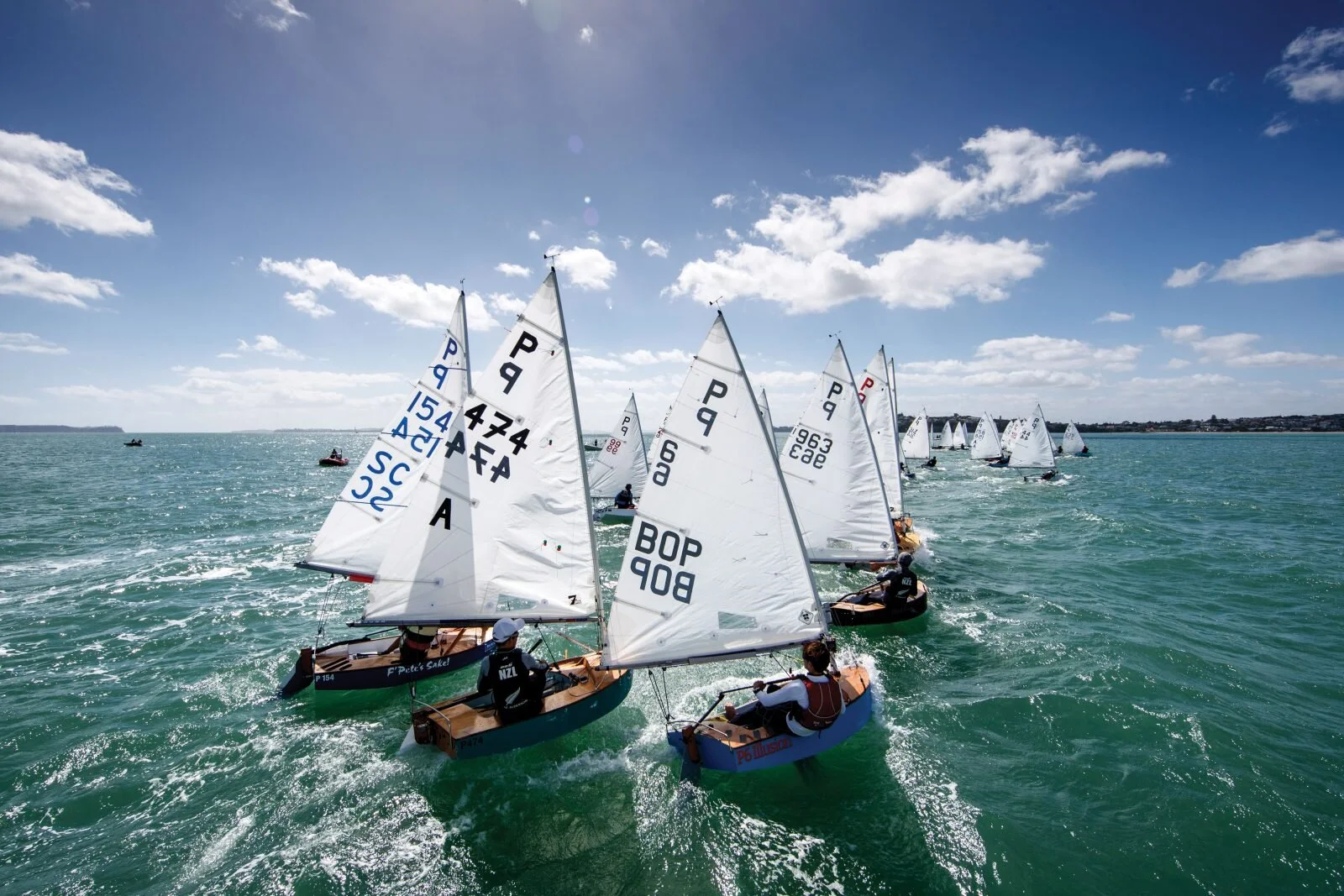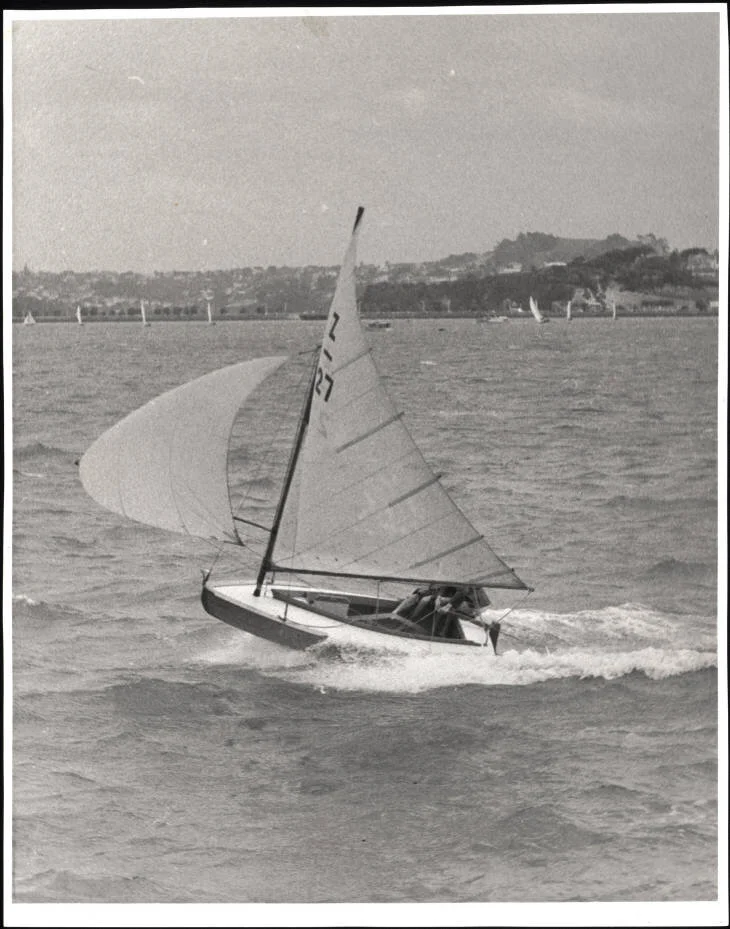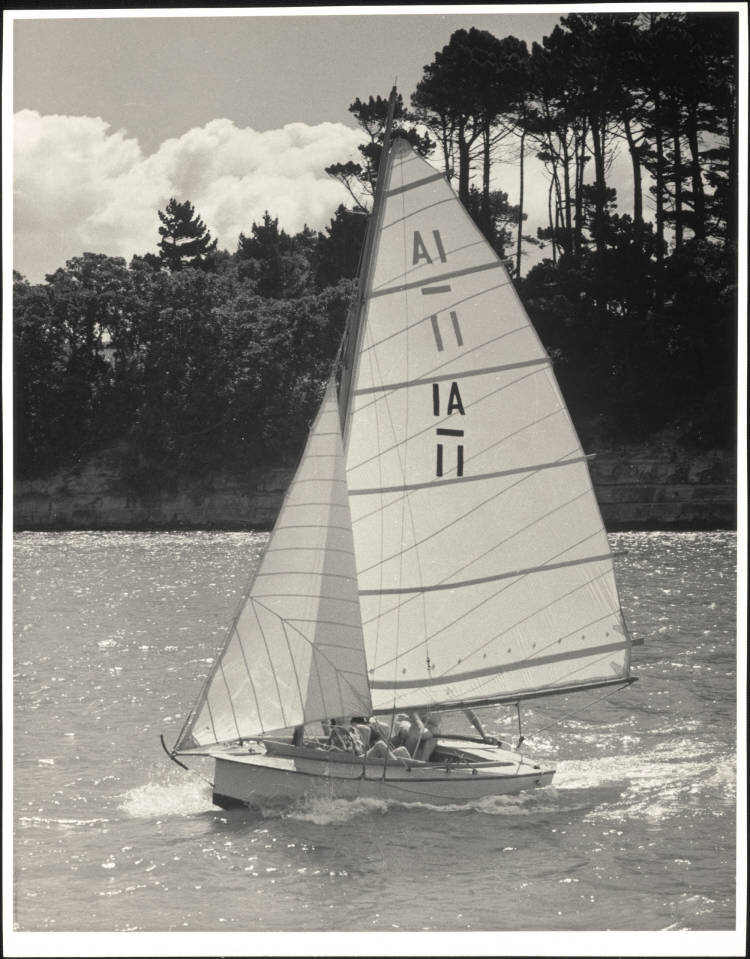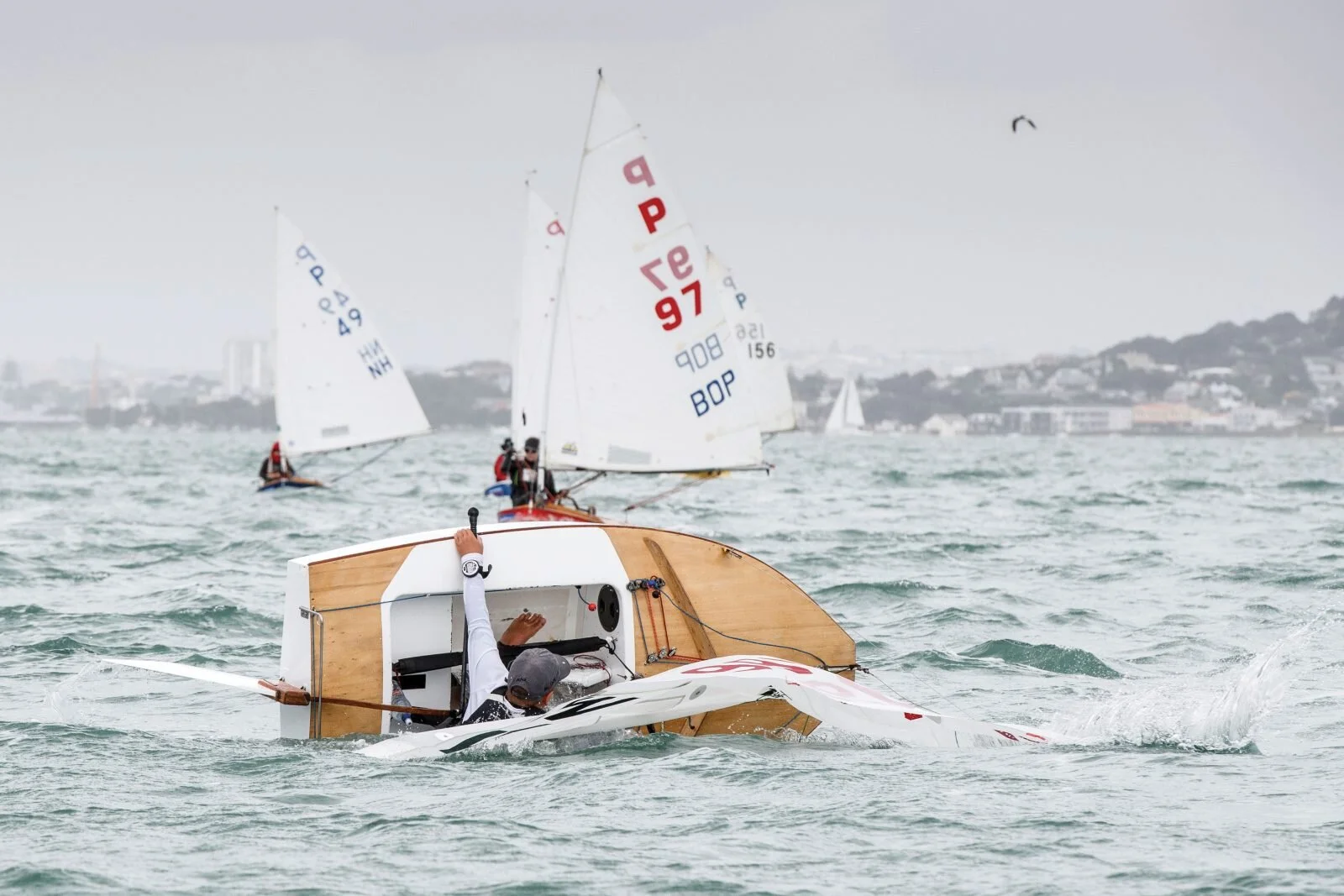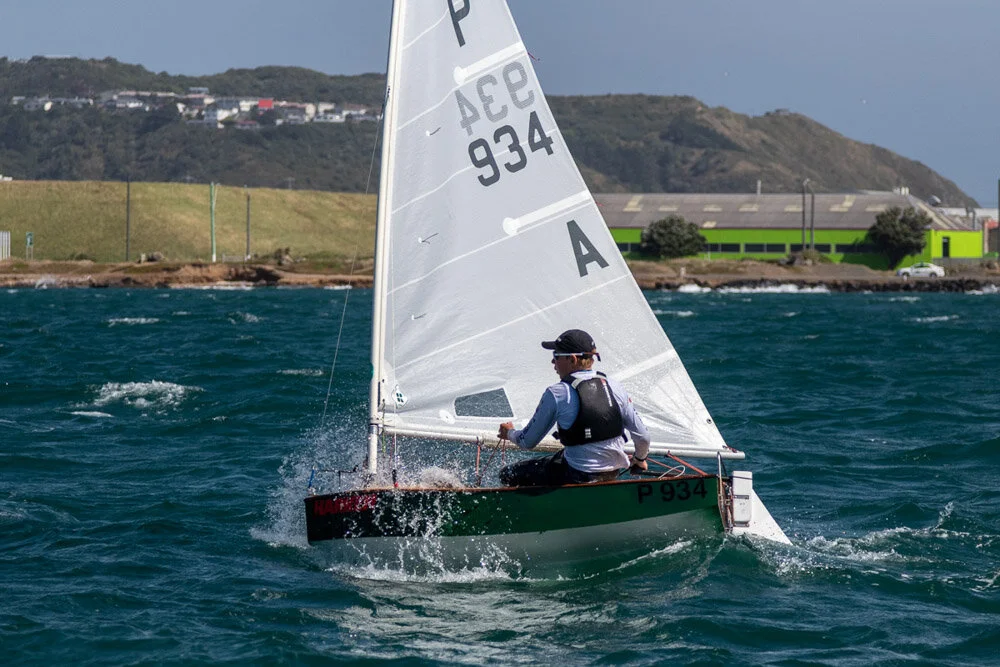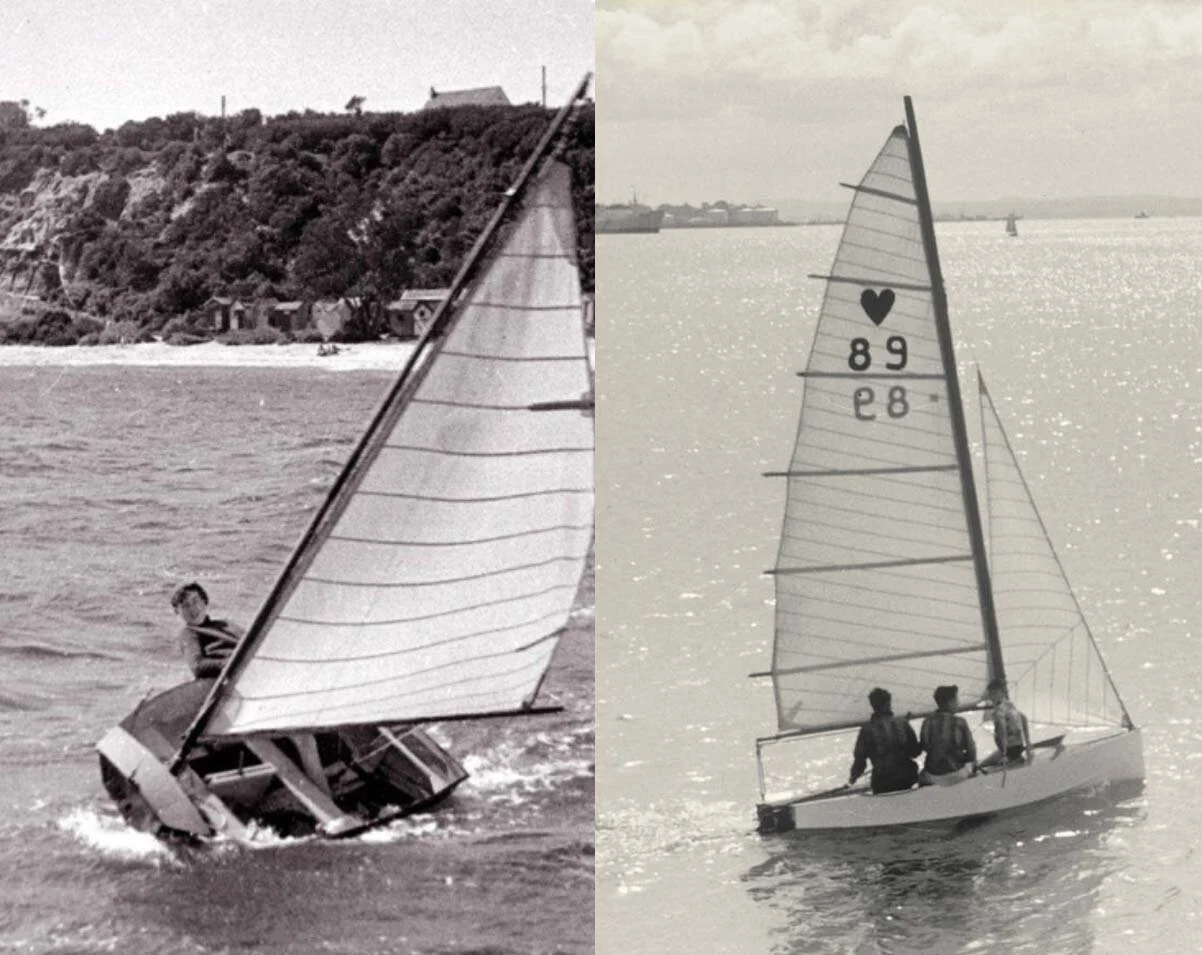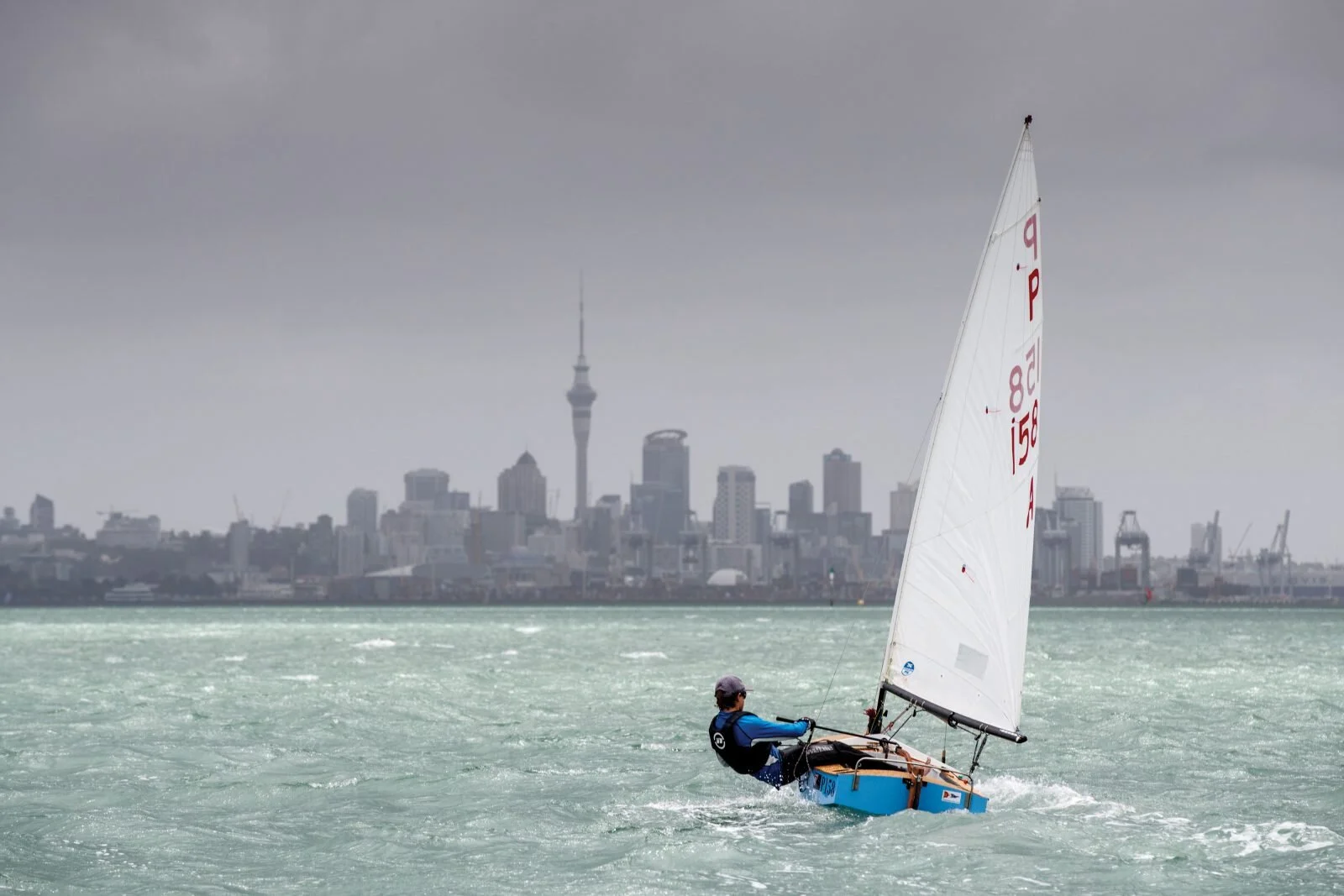Tauranga P Class Why New Zealanders are Good Sailors
P Class Regatta 2019. Photo Richard Robinson
This is our 2nd story about the search for a southern hemisphere junior dinghy.
The challenge for sailing clubs in the first half of the 20C was encouraging small kids to learn sailing instead of bailing. This meant designing a single handed dinghy capable of being sailed in most conditions with skill rather than strength. There were plenty of intermediate youth dinghies that required a bit of weight and experience but few options to get started.
From 1912, Australia was developing junior dinghies like the Albert Park and St Kilda 8 footers. These ultimately proved difficult to sail for young kids, except in sheltered waters and are now considered “lost classes”. See BAIL SAIL or SWIM SWS 24th June.
Australian sailors have always respected and admired their New Zealand neighbours. With a population of only 4.8m, NZ currently holds the America’s Cup, has long pedigree with ocean racing and dinghy design and a healthy tradition of preserving their yachting heritage.
Similarly, New Zealand was thinking about a junior dinghy and in the 1920’s the Tauranga was launched. Unlike the early Australian 8 footers, this little 7 footer is still cherished and sailed, perhaps revealing something about the New Zealand character. For decades it was the single-handed junior trainer of choice in many clubs, because it was difficult to sail.
Zeddie DAWN. North Shore Auckland Harbour C1950
Idle Along SHEIK 1953
EARLY YOUTH CLASSES
From the 1920’s there were many boats suitable for teenagers. Australia had 12ft Cadets, Sydney skiffs and by the 30’s, the popular Vee Jay. New Zealand had two intermediate 12ft classes, the Takapuna or “Zeddie” favoured in Auckland and the Idle Along developed for the notoriously windy capital of Wellington. These were all relatively powerful boats and almost impossible to sail with a junior crew.
The Z Class or “Zeddie” was designed in the 1920’s. She was 12ft 6in length, 5ft beam with a cat rigged 110sq ft main. Rather than a jib, she carried a 60sq ft Australasian “flattie” spinnaker on a long pole and was sailed 2-up. Traditionally planked, often in kauri, the “Zeddie” could weigh 300lb. The Idle Along was designed to survive Wellington harbour’s constant gale winds and was sailed 3-up. It had a low-aspect main on a long boom and small bowsprit jib. The hull had flat hard-chines with steep forward rocker sections and a huge beam of 6ft on 12ft 8in length. By 1939 the Idle Along had become the most popular boat in New Zealand outside of Auckland, which remained loyal to the “Zeddie”.
Like many boats of this era, these heavy hulled designs with low-aspect rigs were compromised in light air and had poor upwind performance but exceptional downwind speed.
TAURANGA P CLASS
P Class fleet on Lake Karapiro (Waikato River) 1949
A little boat was designed in 1919 by civil engineer Harry Highet, intended as a single-handed junior training dinghy before graduation to a “Zeddie”. Highet demonstrated his prototype named MASCOT at a regatta the next year. She was adopted by the Tauranga YC on the Bay of Plenty, North Island in 1923 and given the sail initial “P” for Primer Class. One hundred years later, the Tauranga is still proving herself as a stepping stone on the rise to prominence for New Zealand’s leading sailors. Russell Coutts won his first P Class regatta in Dunedin aged nine. By 22, he was the Olympic gold medallist in the Finn at Los Angeles 1984, before leading the successful NZ America’s Cup challenge in 1995. RC writes;
“This great little boat is a big reason that New Zealand has produced so many good sailors. They are much more demanding boats to sail than the Sabot or Optimist and are one of the most difficult boats to sail downwind in strong winds because they frequently nose-dive. It’s such a complicated boat in terms of balance, sail shapes and tuning that there’s no doubt that if you can master the P Class you can sail almost any boat”
The P Class is 7ft long with 3ft 8in beam, has a flat bottom square-bilged hull and gunter cat-rig with 45sq ft of sail. Highet couldn’t swim so gave the boat extensive decking and buoyancy tanks around a tiny cockpit well. In an era when many small boats would barely float after capsize, the P Class could be easily righted. Tauranga YC had a few rules for the one-design boat. Boys and girls must wear a life jacket, be able to swim and right the boat. Some races actually included a turn-turtle requirement. Seacraft magazine reported from Tauranga YC in 1948;
“Capsize races for this class have always figured on the Club’s program, there being an imposition of two full 360 degree capsizes and recoveries as these races were held in ample depth of water.
The boys and girls (yes there are quite a few girls sailing these little ships and they give excellent account of themselves too) are divided into Juniors and Seniors and with no minimum age, there are some very young people taking part in the races”.
“Capsize races figured on the Club’s program”. Photo Richard Robinson
It took some time before the P Class made big inroads with Auckland harbour clubs. Harold Kidd in the NZ Geographic magazine writes:
“The class failed to take root in Auckland until 1941, when the Ponsonby Cruising Club adopted the little boats to train youngsters to sail, while normal club activities were suspended during the Second World War. They drew kids from the local rugby club nicknamed the Ponies. Their first boat P1 was named PONY.
The club offered evening classes in sailing rules, knots and splices, care of boats and sails, boat construction and sailing techniques. By the end of the war, the class was firmly established at Ponsonby. In 1952 there were more than 140 boats registered in Auckland alone and the Ponsonby Cruising Club could proudly boast of having trained more than 170 boys. Little by little, Auckland’s ‘P Class’ appellation became the recognised name for the type throughout the country”.
P Class Sailors with SHORTY Oriental Bay Marina Wellington 1959. Evening Post
There’s difference in claim about the origin of the appellation “P”, so let’s just say the Tauranga is well named as the kids PONY PRIMER.
After many decades of success, P Class fleets are getting smaller but still supported by NZ junior racers, as “the little boat lacks every convenience that make other boats easy to handle”. Small changes have been made to the original design that did not alter performance. The original square cockpit coaming must have made the back of the legs quite sore after a days hiking. This was removed in favour of a simple prow shaped splash deflector. Like many early classes, hoping to stay current, one-design refinements have been adopted with ply and glass-fibre construction, aluminium and carbon-fibre single spars and even sail control with vang, cunningham and outhaul. However, serious sailors still say the P Class mainly rewards tuning, tactics, physical skills and endurance, as it did a century ago.
The P Class still sails at Tauranga YC alongside the ubiquitous Opti and competes for the Tauranga and Tanner Cups, the celebrated long running regatta for small-boat sailing in New Zealand. In the 2019 competition, the youngest sailor, Sean Kensington aged 11, won the Tauranga Cup in RISQUE and 15 year old Blake Hinsley won the Tanner Cup. Harold Kidd writes;
“The all-comers’ Tauranga Cup, first awarded in Wellington in 1940 and the inter-provincial Tanner Cup, first sailed in 1945, are engraved with the names of New Zealand yachting heavyweights - Russell Coutts, Chris Dickson, Murray Thom, David Barnes, Dean Barker, Craig Monk, Ray Davies and Peter Burling”.
2019 Tanner Cup. Charlie Morton in GREEN DAY. Photo Deb Williams
2019 Tanner Cup. PIECES of EIGHT leads GREEN DAY & MINTIE. Photo Deb Williams
2019 Tanner Cup winner Blake Hinsley in VENGEANCE. Photo Deb Williams
As part of the post-war dinghy boom, the New Zealand P Class found its way to Australia in the 1950’s with a large fleet sailing from Beaumaris YC on Port Phillip just south of Melbourne. Even Nylex Industries, usually selling garden hoses were offering a plastic moulded P Class Trainer-Sailer with “positive buoyancy and leakproof construction” (Seacraft Magazine 1964).
SABOT
The P Class never took hold in Australia and the Sabot finally won the junior dinghy race. The little pram bowed boat was designed in beachside Beaumaris based on a leeboard dinghy with steering oar published in American magazine The Rudder in 1939. The Sabot was adopted by the Black Rock YC in 1947, helping to start Melbourne’s beachside dinghy boom for boys and girls.
CHERUB
It’s easy to see the lineage of the “Zeddie” and Idle Along in the 12ft Cherub. Using ply she was light, fully decked, carried a high aspect rig and raced with two crew. This hugely influential boat was designed by New Zealander John Spencer in 1951 and resolved many previous limitations of the youth classes. The Cherub was a mainstay of many off-the-beach Australian and NZ clubs and is still a successful development class.
Sabot at Black Rock 1950 & Cherub PANDA 1956
PLY & GLUE
Most design innovations usually follow significant technical or material developments. Think steel reinforced concrete or carbon fibre. In buildings, the introduction of reinforced concrete in the early 20C, allowed radically different architecture and column free space. Similarly, many sailing limitations of early dinghies were solved with the introduction of ply and waterproof glue. These were developed in the 1930’s and refined by wartime aircraft construction in the 1940’s. This simple material change drove postwar dinghy design and will be a SWS story coming soon.
Photo Credits:
Zeddie DAWN 1956. Idle Along SHEIK 1953 and Cherub PANDA 1956. Buchanan Collection. Auckland Libraries Heritage Collection.
SHORTY: "In 1959, an Evening Post photographer captured five boys and a P at Oriental Bay Marina Wellington". Alexander Turnbull Library (NZ National Library)
Sabot: From Ron Allatt sailing his own boat.
Bottom two colour photos by Richard Robinson. P Class competing in the 2019 Tanner and Tauranga Cups.

